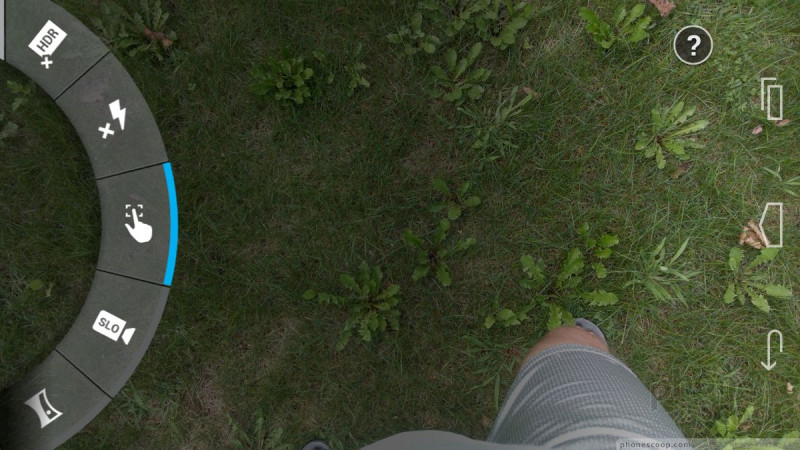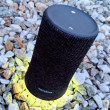Review: Motorola Moto X for AT&T
Media
The Google Play Store is your one-stop-shop for music, movies, TV shows, books, and magazines. It addition to the Store itself, the X comes with all the ancillary apps that are used to interact with each type of content (Play Music, Play Movies, etc.). There are no other installed music or video services, but obviously the app store has plenty from which to pick.
Camera
Motorola made a few changes to the basic Android camera. The changes are welcome and improve usability, but considering how much effort HTC and Samsung put into their camera software, Motorola could have done much better.
To start, the camera can be set to launch with a gesture rather than pushing any buttons. The gesture requires you to hold the phone horizontally and shake your wrist twice (like you're turning a doorknob). You'll then receive vibration feedback that the camera is in fact opening. I like this feature. The X can go from locked to ready-to-shoot in about two seconds. It's really easy to pull the phone out of your pocket and shake it quickly to launch the camera. You don't have to look at the device at all. Neat.
The camera UI is bare bones and there are only two buttons: one for the video camera and another for the user-facing camera. (Every so often, a little "?" appears in the upper right corner. If you're confused about how to use the camera, this offers you a helpful tutorial.) All the settings and controls can only be accessed by swiping from the left side of the viewfinder towards the center. This opens the control dial that has all the options. The Moto X includes HDR (which can be set to come on automatically) and panorama shooting modes, and the flash, geotagging, shutter noise, and touch-to-shoot features can be turned on or off. That's it. No special GIF creating features, or anything fun of any kind.
It took me forever to figure out that dragging your finger from the top of the screen down zooms in, and dragging your finger from the bottom to the top zooms out. Here I was pinching-to-zoom like a fool. Perhaps the one thing I really like is that the camera has an always-on burst mode. Press the screen and hold, and the X will focus and then fire of two shots per second until you take your finger off the screen.
The camera software is step up from stock Android, but barely. You can't adjust scenes, ISO, brightness, or white balance. It's rather limiting if you like to take creative control over the camera. Motorola needs to do a lot of work here to even come close to what its competitors are doing with camera software.
Photos
The Moto X has a 10-megapixel sensor that does a fairly good job. I was particularly impressed with its low-light performance. The X did well getting some shots at a concert I attended, which are typically challenging environments for even the best cameras. Focus was generally nice and sharp, exposure was mostly accurate, and white balance was only off a handful of times. I think there are better cameras out there, but the X's should suffice for most people.
Video
The 1080p HD video I shot looked good, as well. Video captured outdoors in daylight looked the best, as is often the case, but some of the footage I captured at the concert was surprisingly clear and had good audio. The video camera has zero options, so you get what you get once you hit the record button. Most people will be satisfied with the video they capture.
Gallery
The gallery app is the same one that comes with most Android devices. It doesn't offer anything new or different compared to other Jelly Bean phones. It is acceptable for managing photo albums and sharing photos with social networks. It also has a some simple editing features, such as crop, rotate, red-eye reduction, and filters that help correct color, exposure, and other issues.
Apps
The Moto X is relatively free of junky AT&T apps. It has only the MyAT&T and Address Book apps. The rest is stock Google or Motorola.
Bluetooth
The X's Bluetooth radio worked well. I was able to connect with an array of other gadgets and pass phone calls and music to mono and stereo headphones. Calls sounded good through my favorite headset, but the volume was a bit low (even though both phone and headset were turned all the way up). Music also sounded good via Bluetooth, though volume could have been a bit better. One odd bit of behavior: the Moto X cannot push files to other devices. I was able to pair it with my PC and another phone and was not able to send an image file to either device. This should be resolved when the X is updated to Android 4.3.
Browser
The X includes Google's Chrome browser and not the older, generic Android browser. I find Chrome to be the best choice for Android handsets, but there are plenty of alternatives in the Google Play Store. Chrome worked perfectly at rendering web sites over AT&T's network. Web sites were quick to load, for the most part, and web sites looked good on the X's display.
Clock
Thanks to the Active Display feature, there's almost always a clock visible on the Moto X, even when the phone is idle. It could be a little bigger/brighter, but it can be read in most environments other than under direct sunlight.
GPS
The X's GPS radio worked just fine. Google Maps is the only navigation service on board and it worked like a charm. The GPS radio was very quick; it pinpointed me to within about 15 feet in 5 to 10 seconds. Google Maps is a great tool for plotting directions or searching for local points of interest.














































 Hands-On: MOTO X
Hands-On: MOTO X
 Moto Maker Now Available to Sprint, T-Mobile, Verizon
Moto Maker Now Available to Sprint, T-Mobile, Verizon
 Motorola Says Custom Moto X Orders May Not Arrive in 4 Days
Motorola Says Custom Moto X Orders May Not Arrive in 4 Days
 Motorola Intros Skip, Easier Security for the Moto X
Motorola Intros Skip, Easier Security for the Moto X
 Motorola's MOTO X Offers Voice Control and Customizations
Motorola's MOTO X Offers Voice Control and Customizations
 Motorola Moto X (GSM, 1st gen.)
Motorola Moto X (GSM, 1st gen.)




